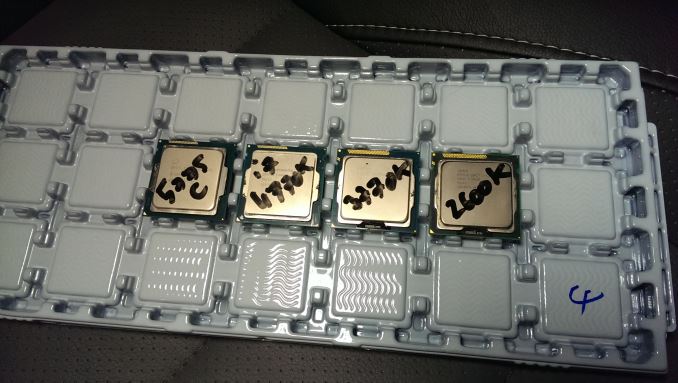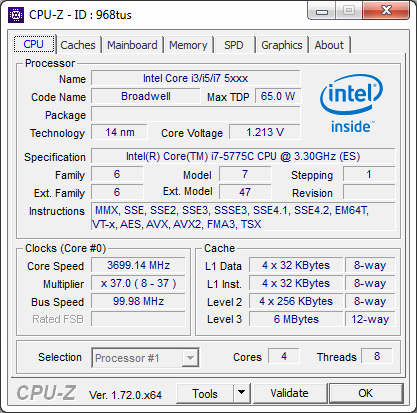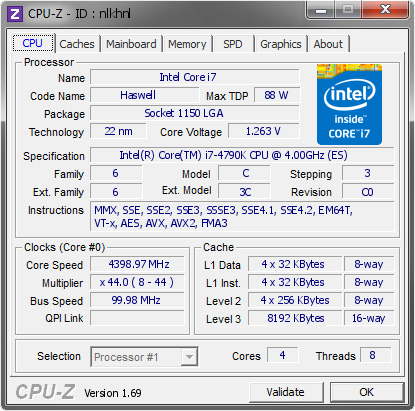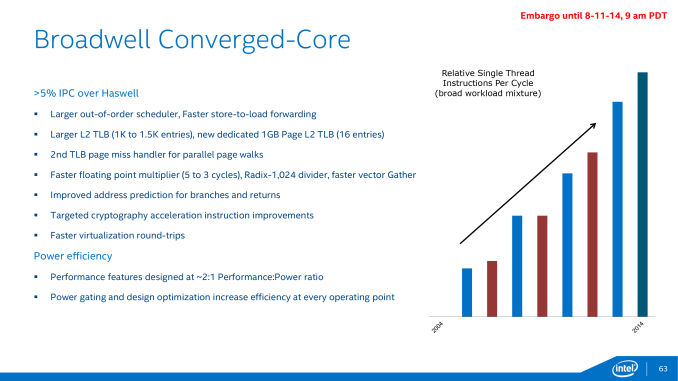The Intel Broadwell Review Part 2: Overclocking, IPC and Generational Analysis
by Ian Cutress on August 3, 2015 8:00 AM EST
In our first part of our Broadwell coverage, we rushed to test both the i7-5775C and the i5-5765C in our new benchmarking suite against the previous generation of Haswell processors as well as AMDs Kaveri lineup. In Part 2, we have spent more time with the architecture to see how it stacks up against the last four years of Intel, as well as probing the high end overclocking capabilities.
Since our Part 1, the news mill from Intel has been an interesting mix of reduced revenue from the PC segments but a rise in expectation as we move from a dull Q2 into an exciting Q3 with back-to-school sales on the horizon and the release of Windows 10. Throw into the mix details about Intel's delayed 10nm process node, the injection of Kaby Lake processors after Skylake to break the tick tock model and it becomes an interesting next few years for the industry.
No matter the state of the tick-tock model (or what seems to be a tick-tock-tock with Kaby Lake), Intel's goals are still the same - improve efficiency of the main processor design and boost peak performance though instruction per clock (IPC) gains with each new processor design release. Simply stating you want an improvement in IPC and actually designing the semiconductor to get a boost in performance are two opposite ends of the difficulty spectrum.
Broadwell vs. Haswell
Intel's line of Haswell (4th generation) processors were released in June 2013, with a small updated design called Haswell Refresh in mid-2014 with improved frequencies and a small a package upgrade to benefit temperatures. Haswell is the name of the architecture, updating from the architecture on Ivy Bridge but on the same 22nm process node as Ivy Bridge. An architecture update incorporates a numerical of things - either a paradigm shift in the underlying semiconductor design, or a step up from the previous orientation by aiming for the low hanging fruit (times which can be updated for the most gain and the least effort). As a result, architecture jumps usually produce big (5-25%) jumps in performance. This is a tock, to use Intel's nomenclature.
| Intel's Tick-Tock Cadence | |||||
| Microarchitecture | Process Node | Tick or Tock | Release Year | ||
| Conroe/Merom | 65nm | Tock | 2006 | ||
| Penryn | 45nm | Tick | 2007 | ||
| Nehalem | 45nm | Tock | 2008 | ||
| Westmere | 32nm | Tick | 2010 | ||
| Sandy Bridge | 32nm | Tock | 2011 | ||
| Ivy Bridge | 22nm | Tick | 2012 | ||
| Haswell | 22nm | Tock | 2013 | ||
| Broadwell | 14nm | Tick | 2014 | ||
| Skylake | 14nm | Tock | 2015 | ||
| Kaby Lake (link)? | 14nm | Tock | 2016 ? | ||
The other half of the equation is a tick, or the movement from a larger process node to a smaller process node. This is by and large a scaled reduction in the mask used for the processor, but there are potential benefits based on the die area of the components of the processor and the connections within. Moving down to a smaller node typically does not change the base hardware underneath, but optimizations are made based on that die area reduction. With this in mind, we typically see smaller benefits in performance (5-10%), but better improvements in power consumption due to smaller transistors needing less voltage (although this is a balance between higher leakage currents). Overall, the typical goal of a process node change is typically efficiency, making it favored in mobile platforms.
Moving from Haswell to Broadwell on the desktop is a process node change, migrating from 22nm on Haswell to 14nm on Broadwell. As a result, the first processors released under the Broadwell nomenclature were mobile focused (Core M), and the desktop end of the stack us the last one to be updated. Though the desktop side is more subtle than that - Intel has released mid-powered versions of the processor with high end integrated graphics, an approach normally reserved for mobile devices or integrated devices such as all-in-ones. Perhaps it is then unsurprising that when desktop processors are launched under the -S or -DT naming scheme, Broadwell on the desktop is part of the -H line, normally reserved for mobile processors.
We've commented on Broadwell's minor architecture adjustments over Haswell before. They focus on reducing cache misses and keeping more predicted operations in flight at any one time, reducing the need to move back out of memory and increase throughput. This is mostly achieved by exploiting the available area when function units are reduced in size from the node change - increasing the out-of-order scheduler size, increasing the L2 TLB to allow for both more local misses/larger memory jump requests, and the page miss handler doubles in size.
This, according to Intel, accounts for a 5% increase in IPC (instructions per clock) by focusing on reducing the wait time for data for the traditional CPU part of the Broadwell processor.
In our initial review of the Broadwell processors, we saw that it was not as straightforward as this. The two CPUs we tested, the i7-5775C and the i5-5675C, are built to a 65W thermal design power, compared to the high end models from Haswell which are at the 84/88W level. This means that for users looking for the next most powerful processor, the base processor frequencies of the Broadwell samples we had are lower and less performant due to frequency, more than any IPC increase could overcome.


Core i7-5775C lining up with the Core i7-4790K
It was difficult for Broadwell to win any CPU focused benchmark from a pure frequency (and TDP) handicap. To add an additional element into the mix, almost every Broadwell's memory cache system is also different:
| Intel Desktop Processor Cache Comparison | |||||
| L1-D | L1-I | L2 | L3 | L4 | |
| Sandy Bridge i7 | 4 x 32 KB | 4 x 32 KB | 4 x 256 KB | 8 MB | |
| Ivy Bridge i7 | 4 x 32 KB | 4 x 32 KB | 4 x 256 KB | 8 MB | |
| Haswell i7 | 4 x 32 KB | 4 x 32 KB | 4 x 256 KB | 8 MB | |
| Broadwell i7 (Desktop / Iris Pro 6200) |
4 x 32 KB | 4 x 32 KB | 4 x 256 KB | 6 MB | 128 MB eDRAM |
|
|
|||||
| Haswell i5 | 4 x 32 KB | 4 x 32 KB | 4 x 256 KB | 6 MB | |
| Broadwell i7 (i7-5700HQ / HD 5600) |
4 x 32 KB | 4 x 32 KB | 4 x 256 KB | 6 MB | |
Both the Level 1 and Level 2 caches of each processor are the same, but at Level 3 where Haswell i7 has 8MB, the Broadwell i7 only has 6MB. Aside from the improved branch predictor mentioned above to reduce cache misses, Broadwell also has a separate eDRAM in the CPU package, weighing in at 128MB. This acts as a level 4 cache, having a latency between the L3 and moving out to memory, resulting in less trips out to main memory. This combination of architecture improvements and eDRAM on Broadwell combined with the lower L3 cache size makes it an unknown in memory performance.
I have also included the Haswell i5 and the Broadwell-based i7-5700HQ in this table, showing that the Broadwell i7 L1/L2/L3 cache hierarchy is more akin to a desktop i5 processor and that Broadwell is available without the eDRAM. That being said, the i7-5700HQ is a single processor destined for laptops, making any discrete testing nominally impossible, and taken out of the real-world context for the majority of Broadwell desktop owners.
The reason for Broadwell's eDRAM comes from Intel's ‘Crystal Well’ strategy. Crystal Well is a designation given to a processor which has this eDRAM (and typically a larger integrated graphics package as well). Integrated graphics are historically inhibited by memory bandwidth, having to almost always reach out to main memory to process textures in graphic workloads. The eDRAM allows more data to be stored between the graphics core and the memory, and at a higher memory bandwidth, potentially improving output. By combining the high end integrated graphics with the eDRAM, Intel created these Broadwell processors as the fastest integrated graphics solution available on a socketable (replaceable processor) platform.
That being said, due to Broadwell being the latest product from Intel, and it having the most recent (and expensive) process node, equipped with eDRAM which is a separate die on the package, the Broadwell solutions do not come cheap. The pricing is almost in line with previous Haswell mainstream i7 processors, albeit at the lower thermal design and the beefier integrated graphics. As we determined in the Broadwell Part 1 review, the desktop Broadwell has the absolute integrated performance crown, although an AMD APU system will be significantly more cost effective. Both platforms are hoping that multi-GPU possibilities in DirectX12 have a positive outcome to their solutions.
This Review
We said we'd be back for part 2, and this is it. Here I wanted to cover what we couldn't previously due to early BIOS revisions and limited time testing - specifically looking at how Broadwell performs when overclocking, and whether the Broadwell architecture is truly a step up over previous generations of Intel processors. In the last review our comparison point was the i7-4770K from Intel's Haswell line; for part two we also back tested the i7-3770K from the Ivy Bridge platform and the i7-2600K from Sandy Bridge, covering the four most recent Intel processor architectures dating back to January 2011. We also have data on older benchmarks going back further. All four of the most recent architectures are tested at their stock speeds and at a constant 3 GHz (at 1866 C9) to find how IPC improves. (Incidentally I did find an i7-750 and a Q9550 in my CPU bin for the next two generations back, but have no motherboards for testing our more recent benchmarks. I'll see what I can put together for a mini-piece later in the year.)
Test setup
| Test Setup | |||||||||||||||||||||
| Processor |
|
||||||||||||||||||||
| Motherboards | MSI Z97A Gaming 6 (LGA1150) ASRock Z77 OC Formula (LGA1155) |
||||||||||||||||||||
| Cooling | Cooler Master Nepton 140XL | ||||||||||||||||||||
| Power Supply | OCZ 1250W Gold ZX Series | ||||||||||||||||||||
| Memory | G.Skill RipjawsZ 4x4 GB DDR3-1866 9-11-11 Kit | ||||||||||||||||||||
| Video Cards | ASUS GTX 980 Strix 4GB MSI GTX 770 Lightning 2GB (1150/1202 Boost) ASUS R7 240 2GB |
||||||||||||||||||||
| Hard Drive | Crucial MX200 1TB | ||||||||||||||||||||
| Optical Drive | LG GH22NS50 | ||||||||||||||||||||
| Case | Open Test Bed | ||||||||||||||||||||
| Operating System | Windows 7 64-bit SP1 | ||||||||||||||||||||
Many thanks to
Thank you to AMD for providing us with the R9 290X 4GB GPUs.
Thank you to ASUS for providing us with GTX 980 Strix GPUs and the R7 240 DDR3 GPU.
Thank you to ASRock and ASUS for providing us with some IO testing kit.
Thank you to Cooler Master for providing us with Nepton 140XL CLCs.
Thank you to Corsair for providing us with an AX1200i PSU.
Thank you to Crucial for providing us with MX200 SSDs.
Thank you to G.Skill and Corsair for providing us with memory.
Thank you to MSI for providing us with the GTX 770 Lightning GPUs.
Thank you to OCZ for providing us with PSUs.
Thank you to Rosewill for providing us with PSUs and RK-9100 keyboards.











121 Comments
View All Comments
Oxford Guy - Tuesday, August 4, 2015 - link
No gaming results.TheJian - Monday, August 3, 2015 - link
I was hoping any more coverage of broadwell would include ripping quality comparisons to haswell at least. Is it still fast but crappy, or have they fixed quality so I don't have to keep my gpu off? :( Throw some handbrake tests in please. Quicksync fixed yet?http://www.anandtech.com/show/7007/intels-haswell-...
Any changes since this? Or the review by anand that covered it (linked in there)? Or do we all just hope for a fix with skylake? I saw a recent software update for haswell, but not sure if that does anything about quality here.
Enterprise24 - Tuesday, August 4, 2015 - link
Grid Autosport with 290X show very strange result. I assume this game support AVX2 instruction set ? Since Sandy and Ivy have roughly the same performance. But jump to Haswell gain big improvement.StrangerGuy - Tuesday, August 4, 2015 - link
Yawn...At this point I'm more interested in much better utilisation of hardware through software like DX12 than sinking tens of billions into CPU die shrinks with next to zero real world benefit. The paradox here is of course how the former will make the latter even more irrelevant as it is.lukarak - Tuesday, August 4, 2015 - link
i7-920 waving...Still no reason to upgrade. It was released in 2008, bought it early 2009. and it has been quite sufficient for almost 6.5 years now.
HeJoSpartans - Tuesday, August 4, 2015 - link
Hello Ian,Unfortunately, your IPC increase charts on page 3 of the article reveal several mistakes. The benchmark charts show that the Broadwell chip is not the fastest on both the 3DPM:ST as well as the CBenchR15:MT benchmarks, while your IPC increase charts tell something completely different. Also, some of the other calculated IPC increase values stated in the charts are completely irreproducable on my side. Second, you made a systematic mistake in calculating the IPC increase for the "Lower is better" benchmarks. This is very crucial especially in the Dolphin benchmark, where the total IPC increase from SB to Broadwell would be 58.0% rather than 36.7%. To make this clear: Processor A, that takes half the time for performing a certain task compared to processor B, does not offer a 50% increase in IPC over B, but a total of 100%.
You should re-check your numbers. Hope this helps.
Ian Cutress - Tuesday, August 4, 2015 - link
Hi HeJoSpartans,Somehow the incorrect benchmark result graphs were placed in those spots and they were from the non 3GHz testing - they also had a different z-height. I have updated it - the IPC numbers for those benchmarks in the main graphs are still accurate. For those benchmarks at stock voltage, the balance between frequency and IPC as to which is more important plays out on a larger scale for sure.
Also, with the timed benchmarks. Arguably I actually labelled the axis in terms of Percentage Improvement rather than IPC improvement, despite the title of the benchmark. But you are correct - I mistakenly used the % improvement and the term IPC interchangeably. I have updated the results with a disclaimer.
Any other issues, let me know. I'm also contactable by email if urgent!
-Ian
Navvie - Tuesday, August 4, 2015 - link
No compelling reason to upgrade from my 4770k.Intel needs to get back to working on CPU development rather than GPU.
Speedfriend - Tuesday, August 4, 2015 - link
I have a question. I have seen a article on Intel that speculates that it intends to launch a new chip that has a larger eDRAM (1Gb) and then has 3d Xpoint (15GB) on. The large eDRAM will compensate for the lower write speed of the 3d Xpoint, however the overall chip will offer massive advantages in power consumption and having nonvolatile memory for sleep states. This would be extremely competitive for mobile computing and servers.Given this quote above "Cycling back to our WinRAR test, things look a little different. Ivy Bridge to Haswell gives only a 3.1% difference, but the eDRAM in Broadwell slaps on another 16.6% performance increase, dropping the benchmark from 76.65 seconds to 63.91 seconds. When eDRAM counts, it counts a lot." would that make sense.
The article says that this change in chip design is the reason we are seeing another tock for kaby lake.
Any view from CPU experts on here?
NeilPeartRush - Tuesday, August 4, 2015 - link
1999: Intel Celeron 300A @ 450MHz2003: AMD Athlon XP-M 2200+ @ 2.40GHz
2007: Intel Q6600 @ 3.60GHz
2011: Intel i5-2500K @ 4.8GHz
2015: Skylake?